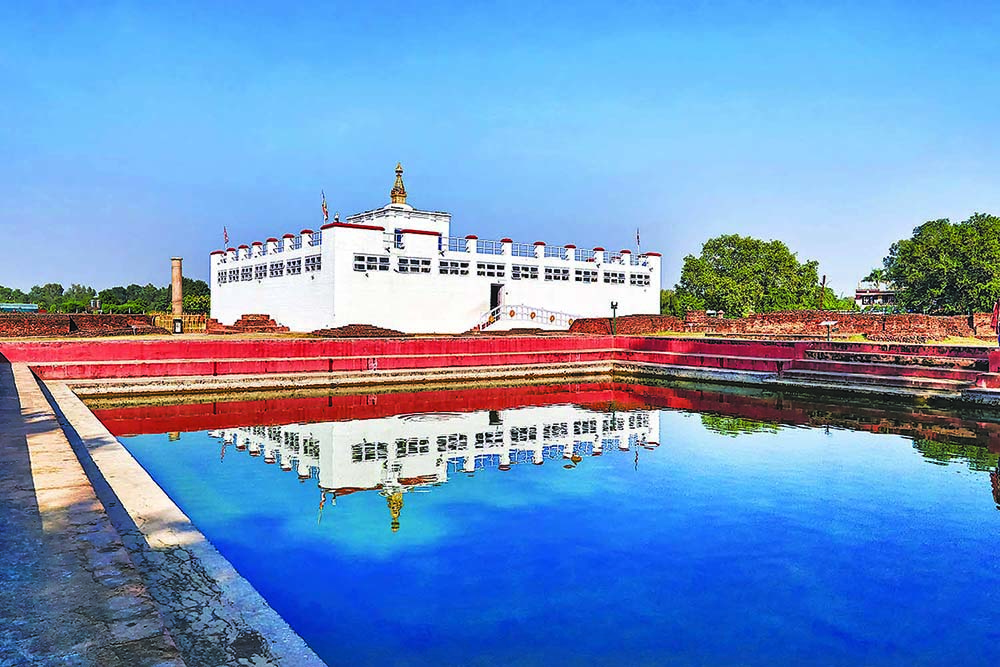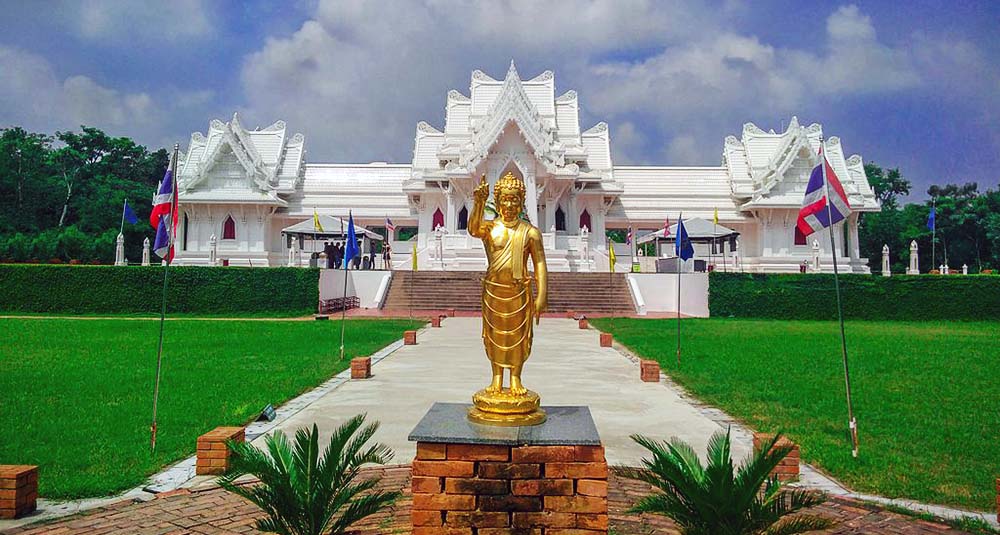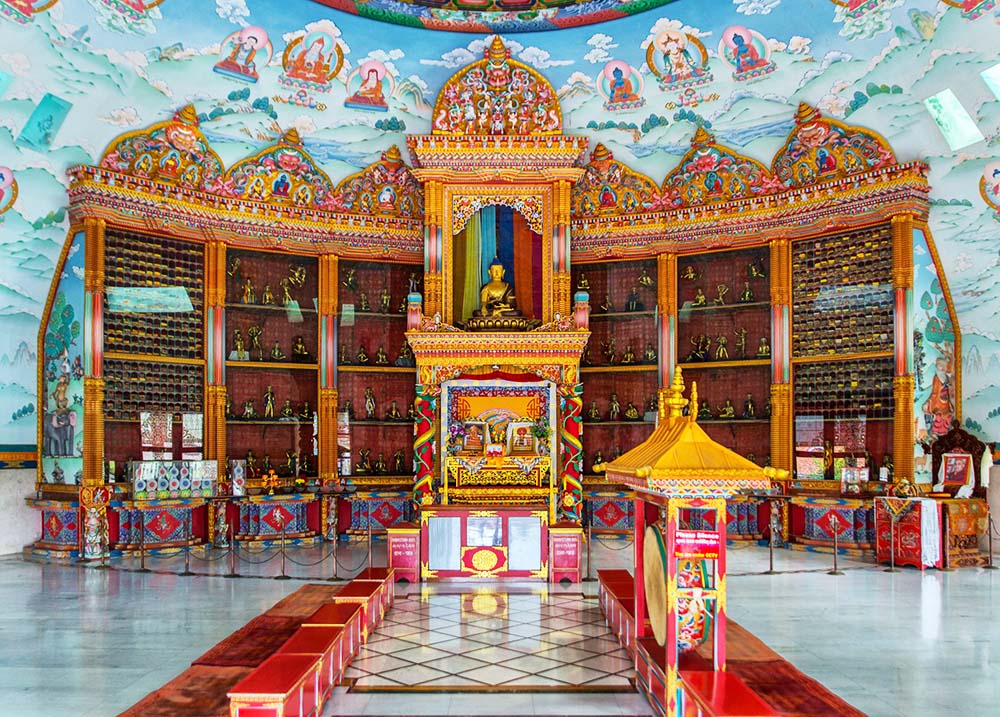When you visit Nepal, it is common to focus on popular destinations like Mt. Everest, Kathmandu, and Chitwan National Park. However, it is important not to overlook the religious significance of Lumbini. This place is considered one of the world's significant pilgrimage destinations as it is the birthplace of the Buddha. If you have an interest in history, spirituality, or archaeology, consider adding Lumbini to your list of must-visit places in Nepal.
Lumbini, the birthplace of Lord Buddha, provides a transformative experience by guiding visitors through his teachings and journey. Lumbini's surroundings offer a plethora of attractions that allow visitors to fully experience the region's rich culture and breathtaking natural beauty.
Lumbini is a central hub that allows for exploration in multiple directions. If you travel west, you will have the opportunity to visit several prominent attractions. These include the Maya Devi Temple, Kudan, Gothihawa, Nilgihawa, Jagidshpur Reservoir, and Sagarhawa. Alternatively, by heading eastward, you will encounter captivating destinations such as Devdaha, Ramagrama, Balmiki Ashram, and Chitwan.
Located north of Lumbini, Butwal is a lively city that serves as a gateway to the scenic hilly regions of western Nepal. It provides a combination of urban amenities and cultural experiences. Tansen, located in the Palpa district, is a hill station that offers a captivating blend of medieval architecture and breathtaking Himalayan views. It serves as a window into the rich cultural heritage of the region. Additionally, be sure to include a visit to the Chhapia fish farm in your itinerary, as it will add another fascinating stop along your east-west route.
It is recommended to allocate approximately 4-5 days to fully experience Lumbini and its surroundings. There are numerous captivating places to visit, providing ample opportunities for exploration and enjoyment during your time there.
Embark on an enchanting journey that takes you beyond Lumbini, the spiritual heart of Nepal. Prepare to uncover a treasure trove of ancient historical sites, immerse yourself in vibrant cultural experiences, and be mesmerized by breathtaking natural landscapes.
Lumbini holds global significance due to its association with Siddharta Gautama, who later became known as the Buddha or the "Awakened One." This is because Lumbini is the birthplace of the Buddha, dating back 2,500 years. A simple plaque and stone are placed at the precise location where Queen Maya Devi held onto a branch of the bodhi tree and gave birth to her son, while on her way back to her home in Kapilavastu.
For more than a millennium, the site remained lost to the world, as Hinduism and Islam became the dominant religions in the subcontinent, replacing Buddhism. In the 19th century, a local Nepali governor, along with British archaeologists from the Raj era, rediscovered the site. They achieved this by comparing the written descriptions of medieval Chinese pilgrims with inscriptions found on sandstone pillars that were two thousand years old. Adorned with marigolds and offerings, Ashoka's pillar remains standing proudly in front of the Maya Devi Temple. It serves as a symbol of Buddhism's peak influence, when it reigned as the predominant faith across the region from Peshawar to Patna.

The birth of Buddha in Lumbini has its origins in the history of the Hindu royals, King Śuddhodana and Queen Mayadevi, who were part of the Gautama family. Despite being raised in a Hindu household, Mayadevi chose to adhere to tradition by leaving her home and traveling to her father's land in order to give birth. This journey ultimately brought her to Lumbini.
According to legend, Mayadevi bathed in what is now called Mayadevi Pool before giving birth while she was on her way to her father's land. The sacred event took place beneath a Sal tree, where Mayadevi stood and held a branch while giving birth to Siddhartha Gautama, who would later be known as The Buddha. Today, visitors can witness the ruins of a temple constructed over the birth site within the Lumbini Temple or Mayadevi Temple. The exact spot is marked out for everyone to see. According to historical records, it is unfortunate to note that Mayadevi passed away shortly after giving birth, just seven days after this significant event.
After the passing of Mayadevi, Siddhartha returned to his father's homeland of Kapilavastu, which is located near Uttar Pradesh in Northern India. He was raised by the younger sister of Maya Devi. The statement "Buddha was born in Nepal" has sparked controversy because while Siddhartha was indeed born in Nepal, he attained enlightenment in India. This issue primarily concerns Nepal and India, and it has little impact on tourists who are interested in exploring the rich history and spirituality of Lumbini, the birthplace of Buddha.

When discussing a visit to Lumbini, it is common for questions to arise about the life of Siddhartha Gautama, also known as The Buddha. Here is a brief summary of his journey: Siddhartha continued to hold the position of crown prince in his father's kingdom. He entered into an arranged marriage at the age of 16 and eventually became a father. At the age of 29, Siddhartha decided to leave his palace and connect with his subjects, despite his father's efforts to protect him.
During his explorations, Siddhartha came face to face with the unavoidable realities of human suffering. This realization was brought about by his encounters with an elderly man, a sick individual, and a decaying corpse. Feeling distressed by what he saw, he chose to embrace the life of a mendicant and devoted himself even more to meditative teachings. Driven by dissatisfaction, he embarked on a quest for enlightenment by engaging in rigorous ascetic practices. These practices involved extreme deprivation of material possessions and self-inflicted suffering, to the extent of surviving on a meager diet of just one nut or leaf per day.
Siddhartha's profound realization was triggered by a near-drowning experience and a childhood memory. He found a balance between self-mortification and concentration as he sat beneath a Pipal tree (Bodhi Tree) and made a vow to stay there until he achieved enlightenment. At the age of 35, after 49 days, he achieved enlightenment and was bestowed with the title "The Buddha" or "The Enlightened One."
Over the course of the next 45 years, The Buddha dedicated himself to spreading his teachings throughout Uttar Pradesh, Bihar, and southern Nepal, despite encountering numerous assassination attempts. At the age of 80, he had a premonition of his upcoming Parinirvana, which is the state of final deathlessness. After consuming a meal that may have included pork or truffles, he became sick. His final words were, "All composite things pass away." "Strive for your own liberation with diligence," echoed the profound wisdom. The Buddha attained Parinirvana in the city of Kuśināra, also known as Kushinagar, located in India. After being cremated, his remains were placed in monuments or stupas as relics. One of these relics is believed to be a finger bone that is currently housed in the stupa at Boudhanath.
Today, the expansive Lumbini complex, stretching over a grand three miles (4.8 km), is an integral component of the vast UNESCO World Heritage Site. The site comprises numerous monasteries constructed by various Buddhist nations, each reflecting their unique national styles. Additionally, it features significant landmarks such as the sacred Bodhi tree, an ancient bathing pond, the renowned Ashokan pillar, and the Mayadevi Temple.
It is not surprising that the temple complex at Lumbini, given its principle of non-attachment, exudes a remarkably relaxed atmosphere. You can expect to witness a continuous stream of pilgrims from Burma, Thailand, and China quietly passing by the main shrine with deep respect. However, the atmosphere of the place never feels overcrowded. The place is not visually stunning, with only a few brick stupa bases and ancient monastery walls remaining. However, there is still the pool where the queen and her infant first bathed. Overall, the site is most notable for its spiritual significance. The location is a serene space for meditation, thoughtful reflection, and profound respect. In Buddhism, the concept of bling is considered to be irrelevant.

Lumbini is approximately 260 kilometers away from Kathmandu. It typically takes approximately 7-8 hours to reach it by ground transfers. If you are interested in flying from Kathmandu, there are daily flights available that take approximately 30 minutes to reach Bhairawaha.
Lumbini can be reached by a five-hour drive from Pokhara. Located near the Indian border, this destination offers convenient access to Uttar Pradesh state in India. From there, travelers can easily continue their journey to visit the Buddhist pilgrimage sites of Kushinagar, where Buddha passed away, and Sarnath, where Buddha delivered his first sermon. Additionally, the captivating sacred city of Varanasi is also within reach.
Lumbini, situated in the southern region of Nepal, is known for its subtropical monsoon climate. The months of May and June are typically the hottest. Rainfall is frequent during the months of June to August, and occasionally continues until the end of September. The climate from December to January is generally warm, with an average temperature of 20°C. However, there are occasions when temperatures can drop to around 8-10°C. October and November are ideal months to visit Lumbini. The climate during this time of the year is favorable. Additionally, one can observe numerous flowers surrounding the temples, which contribute to a serene and aesthetically pleasing atmosphere.In addition, the months of April and May are also considered to be an ideal time to visit Lumbini. Buddha Jayanti is celebrated grandly by devotees during certain months. During this time, many pilgrims come to celebrate this festival.
Lumbini stands out as an unparalleled destination, seamlessly blending cultural, archaeological, and religious significance. Embarking on a journey to Lumbini is akin to walking in the footsteps of Gautam Buddha, an extraordinary figure in the religious realm, amidst serene surroundings that uplift the soul. Here are the must-visit places during your Lumbini trip:
1. Maya Devi Temple
The Maya Devi Temple, a major highlight, is dedicated to Gautam Buddha's mother. This white temple, with its simple design, offers an ideal setting for morning meditation. Positioned at the exact site where Buddha was born under a Banyan tree, it preserves the history of Maya Devi.
2. Ashoka Pillar
Built by Emperor Ashoka in 246 BC, the Ashoka Pillar bears inscriptions designating Lumbini as a tax-free zone. This ancient pillar, dating back to 246 BC, is one of the oldest among the 19 Indian pillars with inscriptions.
3. Puskarni Pond
South of the Ashoka Pillar lies Puskarni Pond, where Buddhist tradition holds that Maya Devi bathed before giving birth to Siddhartha Gautam. Devotees today take a holy dip in the pond, surrounded by remains of ancient brick pagodas and monasteries.
4. Sacred Garden
The Sacred Garden, Lumbini's birthplace of Gautam Buddha, unfolds the story of Buddha's birth and upbringing in his family home.
5. World Peace Pagoda
Situated outside the main compound, the World Peace Pagoda, built by Japanese Buddhists, features a golden statue of Gautam Buddha in a symbolic pose during his birth.
6. Royal Thai Buddhist Monastery
A marvel of architecture, the Royal Thai Monastery showcases grandeur with its white marble structure and a blue-roofed meditation center.
7. Myanmar Golden Temple
One of the oldest structures in Lumbini, the Myanmar Golden Temple houses three prayer halls and embodies Burmese architectural style.
8. Lumbini Museum
Located in the northern part of Lumbini, the museum exhibits artifacts and images from Buddhist sites worldwide.
9. The Great Lotus Stupa
Constructed by the German Tara Foundation, The Great Lotus Stupa adheres to ancient rules and features a meditation hall at its center.
10. Dharma Swami Maharaja Buddha Bihar
In Tibetan style, this Bihar lies outside the main Lumbini area, hosting daily Tara Puja rituals.
11. Zong Hua Chinese Buddhist Monastery
The China Temple, an eye-catching pagoda-style structure, exudes an ancient and peaceful ambiance.
12. Kudan
Situated 4.5 km south of Tilaurakot, Kudan holds structural ruins and a pond where King Suddhodhana met Lord Buddha.
13. Gotihawa
Believed to be the birthplace of Buddha Krakucchanda, Gotihawa features an Asoka pillar and a stupa made of Mauryan bricks.
14. Tilaurakot
Known for ancient ruins of the Shakya Kingdom and Prince Siddhartha Gautama's childhood home, Tilaurakot offers insights into its rich history.
15. Niglihawa, Sagarhawa, and Devadaha
These archaeological sites hold significance in Buddha's life, with ponds, stupas, and ruins contributing to the historical narrative.
16. The Ramgram Kingdom
Located 60 kilometers east of Lumbini, the Ramagram Pagoda houses one of the eight Astha Dhatu (relics) of Lord Buddha.
17. Meditation Class
Lumbini provides an ideal setting for meditation classes, offering a retreat from the hustle and bustle of modern life.
Embark on a journey that transcends time, exploring the birthplace of Gautam Buddha and immersing yourself in the profound spiritual heritage of Lumbini.
If you have any questions, please feel free to write us.
Getaway Nepal Adventure (P.) Ltd.
Thamel Kathmandu, Nepal
Tel: +977 98510 38 908